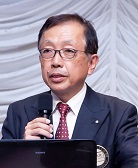Moving towards 2020 with our Tohoku Sukusuku Project
November 28, 2018
Mr. Yuji Hashimoto
Chairman, Challenge 100 Committee,
Tokyo RC
President, SANKO INC.
�� Tokyo RC has been implementing long-term projects every 10 years. Our 10-year ��Rotary Clearland Project�� started in 1999 in Cambodia and we succeeded in removing antipersonnel landmines by collaborating with an international landmine clearance organization, the Halo Trust. Our achievement included clearing the land of 1.3 million square meters where 26,000 people returned to live.
Tokyo RC has been implementing long-term projects every 10 years. Our 10-year ��Rotary Clearland Project�� started in 1999 in Cambodia and we succeeded in removing antipersonnel landmines by collaborating with an international landmine clearance organization, the Halo Trust. Our achievement included clearing the land of 1.3 million square meters where 26,000 people returned to live.
��When we were discussing our next project, the Great East Japan Earthquake struck on March 11th, 2011. We decided to assist disaster-stricken areas in the Tohoku region, north-east of Japan, for 10 years from 2011 to 2020 through the ��Tohoku Sukusuku Project.��
��This project consists of three enterprises. Firstly, the reconstruction of ��Ayukko��, a childcare support center in Rikuzentakada City, which was washed away by the devastating tsunami. With the subsidy of 11 million yen from the Great East Japan Earthquake Reconstruction Fund in addition to contributions worth 10 million yen from the Tokyo RC, it was completed in the early spring of 2012. Mothers got together at ��Ayukko�� and started to support the elderly living in temporary housings, which was an unexpected outcome. To all the facilities we supported, we posted the commemorative plaque saying ��Tohoku Sukusuku Project��, and planted dogwood trees, which are the symbol of Tokyo RC. Every spring beautiful red and white dogwood blossoms bloom in ��Ayukko��.
��Immediately after the Earthquake, direct support came extensively from areas outside, but after the second year financial and in-kind support as well as personnel were mostly terminated. From this stage onwards, community building where local people can support each other becomes more important. Under such circumstances, we shifted our focus on promoting people to support each other as a community and to develop human resources by opening a ��Mothers�� Salon�� and a ��Seminar for Breast-feeding��.
��Just then we found out that there was no such venue in Kesennuma. All they had was a waiting room in a children��s clinic which they rented. So, we decided to build the ��Kesennuma Sukusuku House�� to support community building and human resource development. At this stage, we realized that the support for mothers and children coincides with one of the key elements of the ��Future Vision Plan�� stipulated by the Rotary Foundation. We are convinced that our experiences will certainly be useful for any support required for mothers and children throughout the world in the future.
��Bearing that in mind, we decided to apply for the Global Grant of Rotary Foundation for the construction of ��Kesennuma Sukusuku House.�� Until then the Global Grant has not been used in Japan and Tokyo RC became the first Club to make an application for its large-scale project, following the requirement of RC from disaster-stricken areas to be the recipient and donations from overseas to exceed 30% of the total project cost. We succeeded in receiving generous donations from many RCs and individuals from around the world and launched the 200,000-US dollar-Project with Kesennuma RC as its recipient. Challenge 100 Committee members as well as many Rotarians went out of their way to make this Project come true. ��Kesennuma Sukusuku House�� is now an invaluable facility for mothers raising children, and more than 3,000 people use it each year. The running cost of ��Sukusuku Project�� totals about 6 million yen, which is covered by donations from individual Rotarians, various events organized by Tokyo RC as well as from our District 2580.
��RY 2020-2021 is the last year that Tokyo RC supports the ��Kesennuma Sukusuku House��, but it must be continued over many more years to come. This is why we started to seek support from the local municipality 2 years ago. Our efforts led to the decision to merge the House with a childcare support facility for children of pre-kindergarten age. As they didn��t have knowhow of pre-kindergarten children nor pregnant mothers, the philosophy and expertise of ��Kesennuma Sukusuku House�� were succeeded.
��Tohoku Sukusuku Project which runs up to RY 2020-2021 will launch three new operations. Firstly, the construction and operation of a new childcare support facility in Shingetu District of Kesennuma City located far from other childcare facilities and lacks sufficient provision. It started working on September 10th this year. Secondly, implementation of community programs and human resource development programs in various places, including Namie-machi in Fukushima Prefecture. As Fukushima was contaminated by radiation, it had been outside the scope of our childcare support. As decontamination progressed, we now include Fukushima in our target. Thirdly, building ��Sukusuku Network�� that will connect other childcare facilities run by local governments or service organizations in Tohoku area and exchange with each other by accumulating expertise and hosting joint events.
��Let me highlight some initiatives we must take by the end of RY2020-2021. Firstly, we must make the newly constructed facility in Shingetsu District the permanent facility authorized by the city to be able to receive subsidies from the city. Secondly, we have to compile and store our activity data over the past 10 years and create a report. We hope to leave them as a history of Tokyo RC together with the precious expertise we have acquired over the course of time. Finally, we will plan and organize events to complete our project during RY 2020-2021, which will surely be an impetus for further development of the Tohoku region.
��We have less than 3 years till the end of this project. I would like to ask for your continuous support and guidance, as we are determined to accomplish and hand down the result to our next 10-year project.